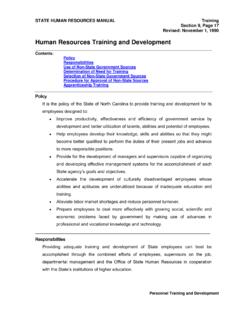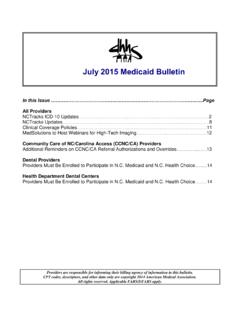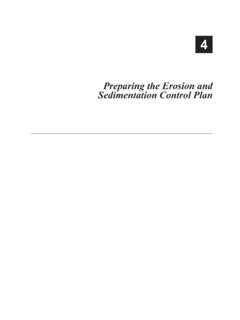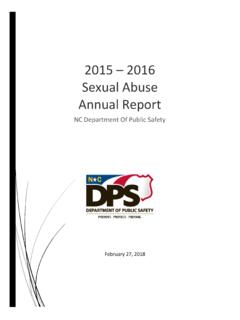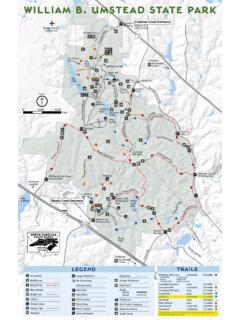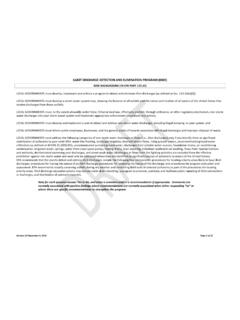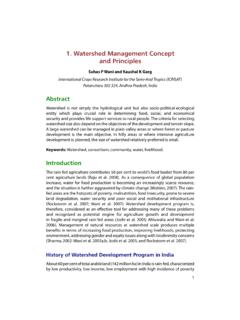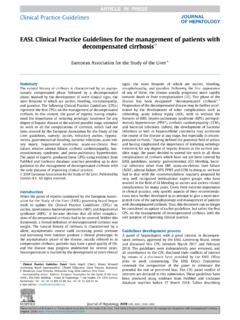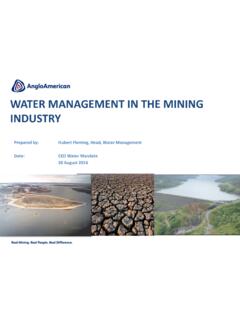Transcription of Stormwater Management Objectives - NC
1 NCDENR Stormwater BMP Manual Chapter Revised 06-16-09. 3. Stormwater Calculations Stormwater Management Objectives The objective of BMPs is to minimize the adverse effects of development by mimicking, as closely as possible, the runoff characteristics of the site in its undeveloped state. These characteristics include: Moderation of runoff peak flows and volumes to minimize downstream erosion and damage to in-stream aquatic habitat. Removal of pollutants such as sediment, nutrients, pathological bacteria and heavy metals. Infiltration of rainfall to replenish the water table and provide stable base flow to streams. The preferred Stormwater Management approach is to preserve the natural storage, infiltration, and pollutant-treatment functions of each drainage area where practical, and where not practical to construct BMPs that mimic those natural functions as closely as possible.
2 Stormwater calculations are required to analyze a proposed new development for its impacts on peak flows and volumes. Stormwater programs in North Carolina typically include provisions to control and treat a certain volume of Stormwater runoff and/or provisions to control the peak Stormwater discharge rate. Additional calculations are required to design BMPs with appropriate treatment capacity and correctly sized outlet structures. Table 3-1 summarizes the Stormwater calculations and allowable methods that will be presented in this chapter. Table 3-1. Summary of Stormwater Calculations Calculation of: Section Allowable Methods Peak Flow Rational Method Runoff Volume Simple Method Discrete SCS Curve Number Method Storage Volume Stage-Storage Table Hydraulic Performance of the Weir Equations Outlet Device Orifice Equation Stage-Storage-Discharge Chainsaw Routing Others: HEC-HMS, WinTR-55, SWIMM.
3 Channel Geometry Manning Equation Nutrient Loading DWQ Neuse TN Export Worksheet DWQ Tar-Pamlico Nutrient Export Worksheet Pollutant Removal of BMPs Stand-alone BMPs Multiple Drainage Areas BMPs in Parallel BMPs in Series Note: Designers may adopt different calculation methods, but the method chosen must provide equivalent or greater protection than the methods presented here. Stormwater Management and Calculations 3-1 July 2007. NCDENR Stormwater BMP Manual Chapter Revised 06-16-09. Peak Flow Calculations Some of the state's Stormwater programs require providing attenuation of peak runoff;. for example, that the post-development flow rate for the one-year, 24-hour storm may not exceed the pre-development flow rate (Neuse and Tar-Pamlico NSW Programs). In addition, it is also important to compute flow rates from the watershed when designing BMPs such as grassed swales, filter strips, and restored riparian buffers.
4 The primary method that is used to determine peak runoff rate for North Carolina's Stormwater programs is the Rational Method. The Rational equation is given as: Q=C*I*A. Where: Q = Estimated design discharge (cfs). C = Composite runoff coefficient (unitless) for the watershed I = Rainfall intensity (in/hr) for the designated design storm in the geographic region of interest A = Watershed area (ac). The composite runoff coefficient reflects the surface characteristics of the contributing watershed. The range of runoff coefficient values varies from 0 , with higher values corresponding to greater runoff rate potential. The runoff coefficient is determined by estimating the area of different land uses within each drainage area. Table 3-2 presents values of runoff coefficients for various pervious and impervious surfaces.
5 The Division believes that the Rational Method is most applicable to drainage areas approximately 20 acres or less. Table 3-2. Rational runoff coefficients (ASCE, 1975; Viessman, et al., 1996; and Malcom, 1999). Description of Surface Rational Runoff Coefficients, C. Unimproved Areas Asphalt Concrete Brick Roofs, inclined Roofs, flat Lawns, sandy soil, flat (<2%) Lawns, sandy soil, average (2-7%) Lawns, sandy soil, steep (>7%) Lawns, heavy soil, flat (<2%) Lawns, heavy soil, average (2-5%) Lawns, heavy soil, steep (>7%) Wooded areas The appropriate value for I, precipitation intensity in inches per hour, can be obtained from the NOAA web site at: This web site Stormwater Management and Calculations 3-2 July 2007. NCDENR Stormwater BMP Manual Chapter Revised 06-16-09. allows the user to select from one of NOAA's numerous data stations throughout the state.
6 Then, the user can ask for precipitation intensity and view a table that displays precipitation intensity estimates for various annual return intervals (ARIs) (1 year through 1000 years) and various storm durations (5 minutes through 60 days). The requirements of the applicable Stormwater program will determine the appropriate values for ARI and storm duration. If the design is for a level spreader that is receiving runoff directly from the drainage area, then the value for I should simply be one inch per hour (more information on level spreader design in Chapter 8). Runoff Volume Many Stormwater programs have a volume control requirement; that is, capturing the first 1 or inches of Stormwater and retaining it for 2 to 5 days. There are two primary methods that can be used to determine the volume of runoff from a given design storm: the Simple Method (Schueler, 1987) and the discrete SCS Curve Number Method (NRCS, 1986).
7 Both of these methods are intended for use at the scale of a single drainage area. Stormwater BMPs shall be designed to treat a volume that is at least as large as the volume calculated using the Simple Method. If the SCS Method yields a greater volume, then it can also be used. Simple Method The Simple Method uses a minimal amount of information such as watershed drainage area, impervious area, and design storm depth to estimate the volume of runoff. The Simple Method was developed by measuring the runoff from many watersheds with known impervious areas and curve-fitting a relationship between percent imperviousness and the fraction of rainfall converted to runoff (the runoff coefficient). This relationship is presented below: RV = + * IA. Where: RV = Runoff coefficient [storm runoff (in)/storm rainfall (in)], unitless IA = Impervious fraction [impervious portion of drainage area (ac)/.]
8 Drainage area (ac)], unitless. Once the runoff coefficient is determined, the volume of runoff that must be controlled is given by the equation below: V = 3630 * RD * Rv * A. Where: V = Volume of runoff that must be controlled for the design storm (ft3). RD = Design storm rainfall depth (in) (Typically, or ). A = Watershed area (ac). Stormwater Management and Calculations 3-3 July 2007. NCDENR Stormwater BMP Manual Chapter Revised 06-16-09. Example Runoff Volume Calculations using The Simple Method: Projects draining to SA or ORW waters in a Coastal County: Effective October 1, 2008, the revised Coastal Stormwater Rules (Session Law 2008-211). stipulate new volume control requirements for high density projects draining to shellfishing waters (SA) or Outstanding Resource Waters (ORW) in the Coastal Counties.
9 The designer must compare different scenarios: runoff from first of rainfall the pre- /post-development for the 1-year, 24-hour criteria provide a useful demonstration of runoff volume calculations used in different North Carolina Stormwater programs. The following example uses the Simple Method (Schueler, 1987) to estimate runoff volume in a hypothetical situation: Example: What is the appropriate runoff volume for choosing and designing a BMP to control Stormwater runoff from a high density development project within one-half mile and draining to SA waters? Description: 4-acre site within a half-mile and draining to SA waters will be developed with a 15,000 sq. foot building ( ac), acre of asphalt road, parking, and concrete walkway areas (see Figure 3-1), and acres of grassy lawn. The rest of the property ( ac) will remain unimproved.
10 Figure 3-1. Schematic of Property for Example Runoff Volume Calculation Drive/Parking area Building Grassy lawn, Unimproved/natural area The BUA density will be ( + )/4 = This will be considered a high-density project as it is above the 12% threshold. Because of this, the engineer must determine which runoff volume is greater in the following design conditions. Note that the area where BMPs will eventually be installed is assumed to be grass areas in these calculations. Stormwater Management and Calculations 3-4 July 2007. NCDENR Stormwater BMP Manual Chapter Revised 06-16-09. First, runoff from the first of rainfall: Calculate the Simple Method Runoff Coefficient with RV = + * IA : RV = + *( ac / 4 ac). = Calculate Runoff Volume with V = 3630 * RD * Rv * A : = 3630 * * * 4. = 5,205 cu. ft Compare the volume difference between the pre- and post-development runoff from the 1-year, 24- hour rainfall event.
